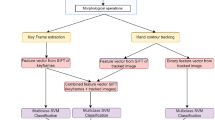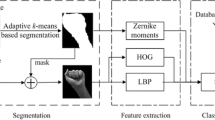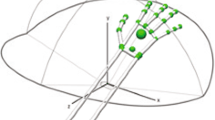Abstract
Sign language recognition systems are gaining importance in recent times as these have established themselves as important elements of human–computer interaction. Also these provide an opportunity for the deaf and hearing impaired to communicate with the common people without the need of an interpreter. Yet there are plenty of challenges in this field which are worth exploring and solutions formulated. In this paper, we have addressed the design of a continuous fingerspelling recognition system which segments a fingerspelling sequence into meaningful extracts and non-sign patterns and thereby recognizes the meaningful signs. Sign segmentation is carried out by means of a unique set of features which comprises of shape matching, velocity change and displacement of centroid between successive frames. Specialized techniques like adaptive thresholding and finite state machine model are also incorporated into our system for efficient classification of sign and movement epenthesis frames. We have validated the performance of our proposed system taking into account the continuous fingerspelling alphabets of American Sign Language considering both native and non-native signers and have obtained an accuracy of almost 91.29%. Our proposed system also has the potential to tackle complex backgrounds involving multiple objects, backgrounds with multiple signers and different brightness conditions.

















Similar content being viewed by others
References
Bhuyan M, Ghosh D, Bora P. Co-articulation detection in hand gestures. TENCON 2005-2005 IEEE region 10 conference. 2005; pp. 1–4. IEEE.
Bhuyan MK, Kumar DA, MacDorman KF, Iwahori Y. A novel set of features for continuous hand gesture recognition. J. Multimod User Interfaces. 2014;8(4):333–43.
Bradski G, Kaehler A. Learning OpenCV: computer vision with the OpenCV library. Newton: O’Reilly Media, Inc.; 2008.
Chen Q, Georganas ND, Petriu EM. Hand gesture recognition using Haar-like features and a stochastic context-free grammar. IEEE Trans Instrum Meas. 2008;57(8):1562–71.
Chetverikov D. A simple and efficient algorithm for detection of high curvature points in planar curves. International conference on computer analysis of images and patterns. Berlin: Springer; 2003. p. 746–53.
Choudhury A, Talukdar AK, Bhuyan MK, Sarma KK. Movement epenthesis detection for continuous sign language recognition. J Intell Syst. 2017;26(3):471–81.
Choudhury A, Talukdar AK, Sarma KK. A conditional random field based Indian sign language recognition system under complex background. 2014 fourth international conference on communication systems and network technologies.2014; p. 900–4. IEEE.
Choudhury A, Talukdar AK, Sarma KK. A review on vision-based hand gesture recognition and applications. Intelligent applications for heterogeneous system modeling and design. IGI Global. 2015; p. 256–81.
Dalitz C, Brandt C, Goebbels S, Kolanus D. Fourier descriptors for broken shapes. EURASIP J Adv Signal Process. 2013;2013(1):161.
Gonzalez R, Woods R. Processing digital image. Chennai: Pearson Education India; 2009.
Hayes MH. Statistical digital signal processing and modeling. New York: Wiley; 2009.
Hse H, Newton AR. Sketched symbol recognition using zernike moments. In: Proceedings of the 17th international conference on pattern recognition, 2004. ICPR 2004, vol. 1, 2004; pp. 367–370. IEEE.
Hsu CW, Lin CJ. A comparison of methods for multiclass support vector machines. IEEE Trans Neural Netw. 2002;13(2):415–25.
Jerde TE, Soechting JF, Flanders M. Coarticulation in fluent fingerspelling. J Neurosci. 2003;23(6):2383–93.
Karray F, Alemzadeh M, Saleh JA, Arab MN. Human–computer interaction: overview on state of the art. Citeseer; 2008.
Kelly D, McDonald J, Markham C. Recognizing spatiotemporal gestures and movement epenthesis in sign language. In: 2009 13th international machine vision and image processing conference, 2009; pp. 145–150. IEEE.
Khotanzad A, Hong YH. Invariant image recognition by Zernike moments. IEEE Trans Pattern Anal Mach Intell. 1990;12(5):489–97.
Kim T, Shakhnarovich G, Livescu K. Fingerspelling recognition with semi-Markov conditional random fields. In: Proceedings of the IEEE international conference on computer vision, 2013; pp. 1521–1528.
Kumar AA. Fundamentals of digital circuits. New Delhi: PHI Learning Pvt. Ltd; 2016.
Kumar P, Saini R, Behera SK, Dogra DP, Roy PP. Real-time recognition of sign language gestures and air-writing using leap motion. In: 2017 fifteenth IAPR international conference on machine vision applications (MVA), 2017; pp. 157–160. IEEE.
Lee HK, Kim JH. An HMM-based threshold model approach for gesture recognition. IEEE Trans Pattern Anal Mach Intell. 1999;21(10):961–73.
Lucas BD, Kanade T, et al. An iterative image registration technique with an application to stereo vision. British Columbia,Vancouver; 1981.
Neustaedter C. An evaluation of optical flow using Lucas and Kanade’s algorithm. Calgary: University of Calgary Department of Computer Science; 2002.
Ormel E, Crasborn O, van der Kooij E. Coarticulation of hand height in sign language of the Netherlands is affected by contact type. J Phonet. 2013;41(3–4):156–71.
Oz C, Leu MC. Linguistic properties based on American sign language isolated word recognition with artificial neural networks using a sensory glove and motion tracker. Neurocomputing. 2007;70(16–18):2891–901.
Papoulis A, Pillai SU. Probability, random variables, and stochastic processes. New York: Tata McGraw-Hill Education; 2002.
Phung SL, Bouzerdoum A, Chai D. Skin segmentation using color pixel classification: analysis and comparison. IEEE Trans Pattern Anal Mach Intell. 2005;27(1):148–54.
Ricco S, Tomasi C. Fingerspelling recognition through classification of letter-to-letter transitions. In: Asian conference on computer vision, 2009; pp. 214–225. Springer.
Segouat J, Braffort A. Toward modeling sign language coarticulation. In: International gesture workshop. Springer; 2009; p. 325–36.
Teague MR. Image analysis via the general theory of moments. JOSA. 1980;70(8):920–30.
Wilson JN, Ritter GX. Handbook of computer vision algorithms in image algebra. New York: CRC Press; 2000.
Yang HD, Lee SW. Robust sign language recognition with hierarchical conditional random fields. In: 2010 20th international conference on pattern recognition, 2010; pp. 2202–2205. IEEE.
Yang HD, Sclaroff S, Lee SW. Sign language spotting with a threshold model based on conditional random fields. IEEE Trans Pattern Anal Mach Intell. 2008;31(7):1264–77.
Yang HD, Sclaroff S, Lee SW. Sign language spotting with a threshold model based on conditional random fields. IEEE Trans Pattern Anal Mach Intell. 2009;31(7):1264–77.
Yang R, Sarkar S. Detecting coarticulation in sign language using conditional random fields. In: 18th international conference on pattern recognition (ICPR’06), 2006; vol. 2, pp. 108–112. IEEE.
Yang R, Sarkar S, Loeding B. Handling movement epenthesis and hand segmentation ambiguities in continuous sign language recognition using nested dynamic programming. IEEE Trans Pattern Anal Mach Intell. 2010;32(3):462–77.
Yang W, Tao J, Ye Z. Continuous sign language recognition using level building based on fast hidden Markov model. Pattern Recogn Lett. 2016;78:28–35.
Zhang D, Lu G. Review of shape representation and description techniques. Pattern Recogn. 2004;37(1):1–19.
Author information
Authors and Affiliations
Corresponding author
Ethics declarations
Conflict of interest
On behalf of all authors, the co****rresponding author states that there is no conflict of interest.
Additional information
Publisher's Note
Springer Nature remains neutral with regard to jurisdictional claims in published maps and institutional affiliations.
Rights and permissions
About this article
Cite this article
Choudhury, A., Talukdar, A.K., Sarma, K.K. et al. An Adaptive Thresholding-Based Movement Epenthesis Detection Technique Using Hybrid Feature Set for Continuous Fingerspelling Recognition. SN COMPUT. SCI. 2, 128 (2021). https://doi.org/10.1007/s42979-021-00544-5
Received:
Accepted:
Published:
DOI: https://doi.org/10.1007/s42979-021-00544-5




